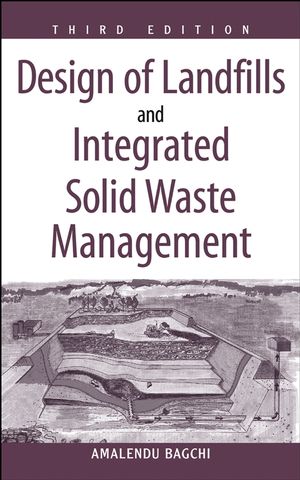Design of Landfills and Integrated Solid Waste Management, 3rd EditionISBN: 978-0-471-25499-7
Hardcover
712 pages
February 2004
 This is a Print-on-Demand title. It will be printed specifically to fill your order. Please allow an additional 10-15 days delivery time. The book is not returnable.
|
||||||
PART I: INTEGRATED SOLID WASTE MANAGEMENT.
1 Introduction.
1.1 Basic Concepts of an Integrated Solid Waste Management Program.
1.2 Scope and Organization of Book.
2 Integrated Solid Waste Management.
2.1 Planning.
2.2 Benefits of ISWM.
2.3 Regulatory Issues.
2.4 Public Promotion of ISWM.
2.5 Collection and Transportation of Waste.
2.6 Transfer Stations.
2.7 Waste Composition Study.
3 Source Reduction.
3.1 Role of Governmental Bodies.
3.2 Planning.
3.3 Source Reduction Ideas.
3.4 Reducing Toxicity.
4 Medical Waste Management.
4.1 Definition of Infectious Waste.
4.2 Source Separation and Management.
4.3 Storage.
4.4 Transportation.
4.5 Treatment.
4.6 Tracking.
4.7 Collection of Infectious Waste Generated from Homes.
4.8 Waste Reduction.
5 Incineration.
5.1 Incinerable Waste.
5.2 Waste Load Estimate.
5.3 Types of Incinerator.
5.4 Environmental Issues.
5.5 Incineration of Various Nonhazardous Waste Types.
5.6 Site Selection, Installation, and Financing.
6 Composting.
6.1 Fundamentals of Composting.
6.2 Influence of Various Parameters on Composting.
6.3 Facility Design.
6.4 Environmental Issues.
6.5 Health and Safety.
6.6 Marketing.
6.7 Economics.
7 Reuse and Recycling.
7.1 Planning.
7.2 Marketing.
7.3 Information on Recyclable Materials Recovered from Municipal Solid Waste.
7.4 Material Recovery Facilities.
7.5 Refuse-Derived Fuel Processing Plants.
7.6 Quality Control and Data Collection.
7.7 Land Spreading.
8 Reuse of Industrial By-Products.
8.1 Comments on Engineering Characteristics and Testing Protocols.
8.2 Reuse of Industrial By-Products in Civil Engineering Projects.
8.3 Environmental Issues.
9 Contaminated Soil Remediation.
9.1 Soil Contamination Process.
9.2 Factors Affecting Remedial Processes.
9.3 Contaminant Transport.
9.4 Maintenance of Wells.
9.5 Site Investigation.
9.6 In Situ Remediation Methods.
9.7 Ex Situ Remediation Methods.
9.8 Project Life Estimation.
9.9 Project Cost Estimation.
9.10 Comments on Remediation Method Selection.
10 Redevelopment of Contaminated Land.
10.1 Risk Assessment.
10.2 Risk-Based Corrective Action for Redevelopment of Contaminated Land.
10.3 Legal Issues.
10.4 Funding.
PART II:LANDFILL DESIGN.
11 Introduction.
11.1 Comments on Regulatory Requirements.
11.2 Scope and Organization of Part II.
12 Site Selection.
12.1 Data Collection.
12.2 Locational Criteria.
12.3 Preliminary Assessment of Public Reactions.
12.4 Development of a List of Potential Sites.
12.5 Final Site Selection.
12.6 Preparation of Feasibility Report.
13 Leachate and Gas Generation.
13.1 Factors That Influence Leachate Quality.
13.2 Factors That Influence Leachate Quantity.
13.3 Assessing Probable Quality of Leachate.
13.4 Estimation of Leachate Quantity.
13.5 Typical Leachate Quality of Various Nonhazardous Wastes.
13.6 Leachate Treatment.
13.7 Gas Generation.
14 Waste Characterization.
14.1 General Guidelines for Waste Characterization.
14.2 Identification of Hazardous Waste.
14.3 Restriction on Land Disposal of Hazardous Waste.
14.4 Identification of Nonhazardous Waste.
15 Natural Attenuation Landfills.
15.1 Natural Attenuation Process.
15.2 Mechanisms of Attenuation.
15.3 Effects of Various Factors of Attenuation Mechanisms.
15.4 Attenuation Mechanisms of Specific Pollutants.
15.5 Design Approach.
15.6 Summary and Comments.
16 Containment Landfills.
16.1 Single-Lined Landfills.
16.2 Double- or Multiple-Lined Landfills.
16.3 Liner Material Selection Criteria.
16.4 Comments on Liner Thickness.
16.5 Comments on Final Cover Design.
16.6 Leachate Apportionment Models.
16.7 Comments on Designing the Landfill Base below the Groundwater Table.
16.8 Check for Liner Blowout.
16.9 Natural Attenuation versus Containment Landfill.
17 Bioreactor Landfills.
17.1 Microbiology of Landfills.
17.2 Potential Advantages of Bioreactor Landfills.
17.3 Bioreactor Landfill Design.
17.4 Slope Stability.
17.5 Potential Obstacles to Bioreactor Landfill Development.
18 Liner Materials.
18.1 Clay.
18.2 Synthetic Membrane.
18.3 Geosynthetic Clay Liner.
18.4 Amended Soil and Other Admixtures.
18.5 Composite Liner.
19 Design of Landfill Elements.
19.1 Leachate Collection System.
19.2 Stormwater Routing.
19.3 Geosynthetic Membrane.
19.4 Berm Design.
19.5 Landfill Stability.
19.6 Comments on Seismic Design of Landfills.
19.7 Access Road Design.
19.8 Landfill Cover Design.
19.9 Gas Venting System Design.
19.10 Converting Existing Natural Attenuation Landfills to Containment Landfills.
20 Landfill Construction.
20.1 Subbase Construction.
20.2 Liner Construction.
20.3 Berm Construction.
20.4 Sand Drainage Blanket Construction.
20.5 Leachate Collection Trench Construction.
20.6 Double- or Multiple-Liner Construction.
20.7 Groundwater Dewatering System Construction.
20.8 Lysimeter Construction.
20.9 Landfill Cover Construction.
20.10 Material Procurement, Construction Scheduling, and So On.
20.11 Erosion Control during Landfill Construction.
20.12 Construction on Landfills.
21 Landfill Remediation.
21.1 Site Investigation.
21.2 Developing a Priority List.
21.3 Selection of Remedial Methods and Related Issues.
22 Performance Monitoring.
22.1 Leachate Head Monitoring.
22.2 Monitoring Head in the Groundwater Dewatering System.
22.3 Leakage Monitoring.
22.4 Groundwater Monitoring.
22.5 Gas Monitoring.
22.6 Leachate Tank Monitoring.
22.7 Final Cover Stability Monitoring.
22.8 Groundwater Data Analysis.
23 Landfill Operation.
23.1 Equipment Used for Compaction.
23.2 Phasing Plan.
23.3 Covering Waste.
23.4 Co-disposal of Nonhazardous Sludge in Municipal Landfills.
23.5 Fire Protection.
23.6 Litter Control.
23.7 Dust Control.
23.8 Access Road Maintenance.
23.9 Leachate Collection System Maintenance.
23.10 Final Cover Maintenance.
23.11 Comments on Enforcement-Related Issues.
23.12 Landfill Mining.
24 Compensatory Wetland Development.
24.1 Wetland Identification.
24.2 Wetland Determination and Delineation.
24.3 Wetland Functions and Values.
24.4 Wetland Protection.
24.5 Wetland Restoration and Creation.
24.6 Wetland Mitigation.
24.7 Long-Term Evaluation.
25 Health and Safety.
25.1 Sources of Occupational Health Hazards.
25.2 Personal Protective Equipment.
25.3 Elements of a Health and Safety Program.
26 Economic Analysis.
26.1 Cost Estimates.
26.2 Estimate for Proof of Financial Responsibility.
26.3 User Fee Estimate.
26.4 Cash Flow Estimate.
APPENDIX: CONVERSION OF U.S. CUSTOMARY UNITS TO INTERNATIONAL SYSTEM OF UNITS (SI).
REFERENCES.
INDEX.



